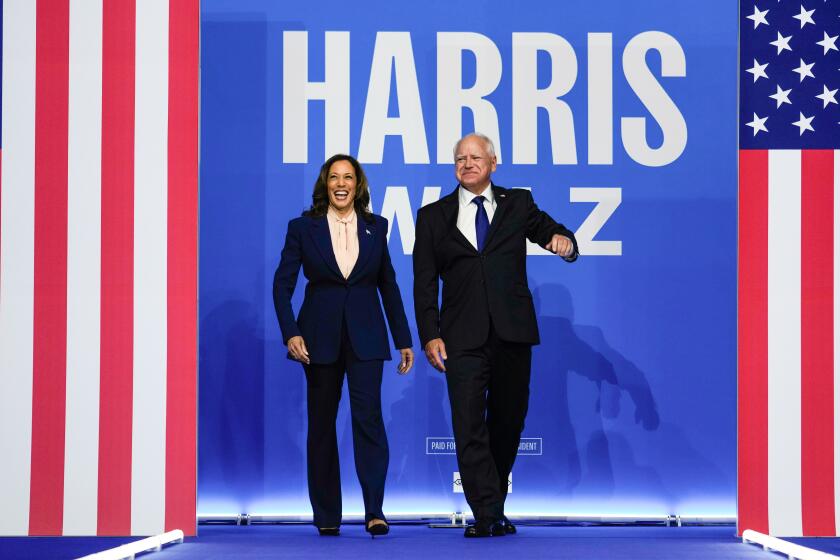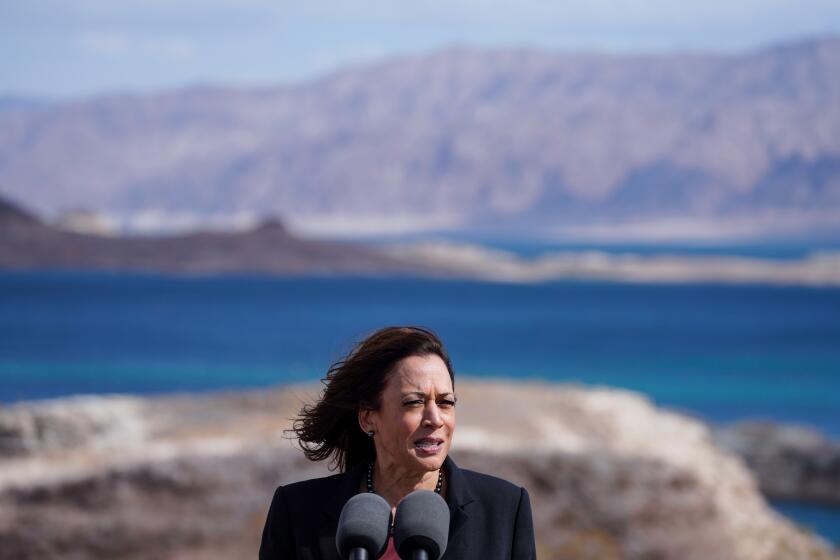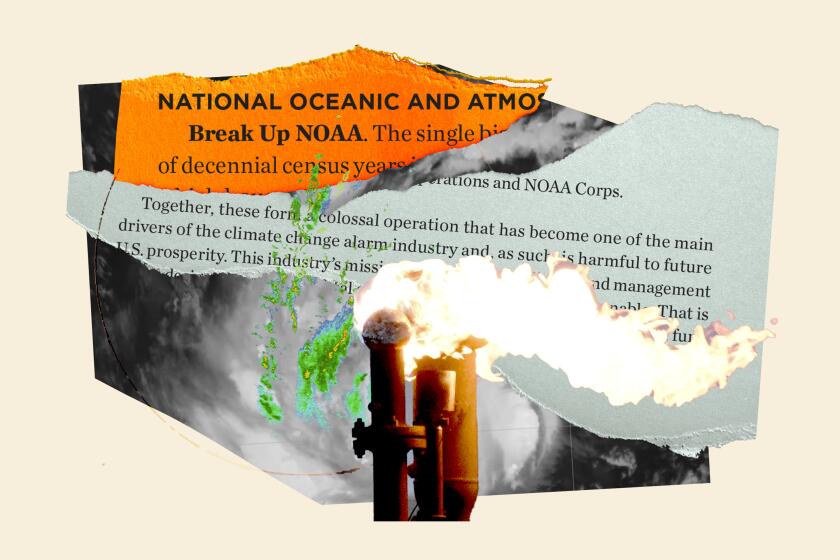
The run-up to the 2024 presidential election has been supercharged by hot-button issues ranging from abortion to immigration. But for many voters, climate change remains top-of-mind as the country continues to grapple with devastating storms, explosive wildfires and record-breaking heat waves.
Vice President Kamala Harrisâ Democratic running mate, Minnesota Gov. Tim Walz, has an impressive track record when it comes to climate action, experts and advocates say. During his tenure as governor, Walz has passed dozens of initiatives focused on clean energy and transportation, air and water quality, and environmental justice â many of which mirror Californiaâs own ambitious goals.
âCaliforniaâs reputation as a climate leader is well-deserved, and Walz is a perfect example of what that looks like,â said Mike Young, senior political and organizing director with California Environmental Voters.
âItâs actually a great pairing because at the top of the ticket is somebody from California whoâs also been a champ,â he said, referring to Harrisâ own climate record. âAnd climate and clean energy and environmental justice are key areas where nationally they should continue to lead, and certainly in California and Minnesota they should continue to lead.â
Aggressive and impactful reporting on climate change, the environment, health and science.
Transitioning Minnesota toward clean energy and reducing the stateâs fossil fuel emissions have been some of Walzâs top environmental priorities as governor. His Climate Action Framework, released in 2022, notes that âclimate change is an existential threat for all people in Minnesota.â
Among its stated goals are slashing Minnesotaâs greenhouse gas emissions in half by 2030 and achieving carbon neutrality by 2050. (California has set a similar goal of reaching carbon neutrality by 2045.)
To get there, Walz has worked to accelerate renewable energy projects in the state, including recent legislation to expedite the process for permitting wind and solar projects by as much as 12 months.
Whatâs more, Walzâs plan will require Minnesota utilities to generate 100% of their electricity from carbon-free sources by 2040 â a goal that is âeven more ambitious than similar measures in traditionally progressive states,â according to Cassidy DiPaola, communications director for the nonprofit Fossil Free Media.
âGovernor Walzâs evolution into a climate champion, sparked by witnessing the impacts of extreme weather on his rural constituents, reflects a growing understanding of climate change as an immediate and devastating threat to communities across America,â DiPaola said in a statement.
Walz also signed an executive order in 2019 that established a climate change sub-Cabinet in the state, which is tasked with identifying new strategies to meet greenhouse gas reduction goals and âprepare Minnesota for the impacts of climate change that cannot be avoided or mitigated.â
Since the passage of President Bidenâs landmark climate bill, the Inflation Reduction Act, in 2022, Minnesota has seen $1.15 billion in clean energy investments and nearly 2,000 new clean energy jobs, according to an assessment from the group Climate Power.
Kamala Harris has selected Minnesota Gov. Tim Walz as her running mate. The moderate Democrat demonstrated the ability to work with Republicans when he was in Congress.
But energy is just one component of Walzâs environmental record. The governor has also advocated heavily for transportation projects that will expand the use of electric vehicles, tighten pollution standards for cars and trucks, and enhance public transit and e-bike options.
Last year, Minnesota became the first state in the Midwest to adopt Californiaâs strict tailpipe emission standards â despite significant opposition from state Republicans and the Minnesota Auto Dealers Assn., who bemoaned in a court petition that âMinnesota is not California.â
The Clean Cars Minnesota rule went into effect this year after a lengthy legal battle, and requires car manufacturers to make and deliver passenger vehicles that produce less pollution, and to deliver more zero-emission vehicles to the state for consumers to purchase.
The rule does not go so far as to ban the sale of gas cars, which California will do beginning in 2035. However, Walz has outlined other plans to accelerate Minnesotaâs transition to electric vehicles, with his climate framework calling for increased EV charging infrastructure, reduced EV costs and more accessible EV options. The plan seeks to have at least 20% EVs on Minnesota roads by 2030.
Young said it makes sense that Walz would look to Harrisâ home state for inspiration, and that doing so speaks to his strength as a public servant who makes decisions based on what will serve people best.
âI donât think he cares about where the idea comes from if itâs a good idea,â Young said. âIf California has some great environmental ideas, why limit them to California?â
Walz this year applied for $39 million in federal funds from the U.S. Environmental Protection Agency to help connect Midwestern states through an electric truck charging network for heavy-duty vehicles. His transportation funding law, passed in 2023, is also expected to generate $440 million per year geared toward improving public transit and accelerating the build-out of an electric bus system.
Harris, a Californian who calls climate change an âexistential threat,â has prioritized investments in clean energy jobs and environmental justice.
But Minnesota â a Great Lakes state that is home to thousands of waterways â has also prioritized clean water and air protections under Walzâs watch.
The governor last year signed a $2-billion environment and climate bill that includes the strictest regulations on PFAs, or âforever chemicals,â in the country. The bill includes environmental justice initiatives, such as requirements that the Minnesota Pollution Control Agency consider past pollution when issuing new or renewed air permits.
Additionally, Walzâs 2024 budget calls for more than $215 million in water and transportation infrastructure investments for programs such as lead pipe replacements, nitrate monitoring and removing PFAs from drinking water.
But his climate record is not without its stains.
A report published this month by the group Heated focused on a crude-oil pipeline project that was approved early in Walzâs term as governor. The pipeline runs through protected Indigenous lands as well as lakes, rivers and other waterways in the state, and Indigenous leaders told Heated that they saw the projectâs progression as a betrayal of past promises.
The call to dismantle the United Statesâ vital weather department has raised the hackles of experts who say NOAA provides not only important free data but also life-saving information.
However, others remain optimistic about Walzâs ability to push the presidential ticket forward when it comes to climate efforts.
âAs Governor, Tim Walz has made huge strides to address the climate crisis,â read a statement from Stevie OâHanlon, communications director with the Sunrise Movement. âHe has done this by pitching climate action as a way to make peopleâs everyday lives better, create good-paying green jobs, and invest in making communities stronger.â
Indeed, Walzâs ability to communicate effectively about global warming has been a strength on the campaign trail. During a July âWhite Dudes for Harrisâ fundraising call viewed by more than 200,000 people, he criticized the Republican ticket for ânot addressing climate change thatâs going to impact communities that are less fortunate than anyone else.â
âWe have communities that are going to pay the price because we donât address it,â Walz told the audience.
The remarks stand in stark contrast to not only those of Donald Trump â who installed climate change deniers in his administration and tried to roll back more than 100 environmental regulations during his presidency â but also his running mate, Ohio Sen. JD Vance, who has called electric vehicles âa scamâ and said he doesnât believe there is a climate crisis.
âVoters will have a clear choice between a Harris-Walz ticket, who will fight for our clean energy future that lowers harmful pollution and creates safer communities, or a Trump-Vance administration whose pro-polluter, extreme MAGA agenda will give Big Oil a free pass to profiteer and pollute,â read a statement from Lori Lodes, executive director of Climate Power.
Walz also took environmental stances during his time in Congress, where he served in the House of Representatives from 2007 to 2019 before becoming governor of Minnesota.
In 2017, he condemned Trumpâs decision to withdraw from the Paris climate agreement as a move that âweakens U.S. national security, food security, moral/global leadership â and lets down our kids.â (President Biden reentered the agreement on his first day in office.)
Among Walzâs votes at the time were opposition to legislation to remove protections for public lands; opposition to a bill to expand offshore oil drilling; and opposition to a bill to prohibit the federal government from setting baseline protections from fracking.
Walz also didnât mince words when Trump rolled back a signature Obama-era climate policy known as the Clean Power Plan in 2017 â issuing a statement denouncing the order as denying âthe very existence of climate change.â
âThe science on climate change is settled,â Walz said.
Toward a more sustainable California
Get Boiling Point, our newsletter exploring climate change, energy and the environment, and become part of the conversation â and the solution.
You may occasionally receive promotional content from the Los Angeles Times.











